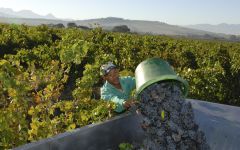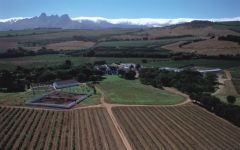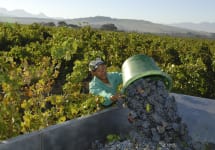Meerlust Chardonnay 2022
-
Wine
Spectator -
James
Suckling -
Wine
Enthusiast



Product Details
Your Rating
Somm Note
Winemaker Notes
Very bright pale-yellow colour with green, vivacious hue. Complex, appealing nose of apricot, peach, pear, lemon zest and floral notes with hints of toasted almonds. On the palate the wine is well structured and linear but retains generous focused stone fruit flavours with sleek, balanced, and crisp acidity. The wine remains vivacious and fresh on the finish with clean citrus fruit underpinned by minerality. The wine has a long, very pleasant lingering finish.
Enjoy with grilled fish, white and red meat.
Professional Ratings
-
Wine Spectator
A harmonious, medium-bodied white, with a creamy mesh of creamed apple, lemon curd, toasted hazelnut and lime blossom notes. Shows good length and a pleasing roundness on the palate, with a fresh, spiced finish. Drink now through 2029.
-
James Suckling
Toasty chardonnay showing smoked almond, oat, lemon curd and pie crust aromas. Medium to full body, ripe and flavorful.
-
Wine Enthusiast
This Chardonnay has weight and energy. It opens with aromatic patisserie spices, but chamomile and citrus fruit dominate the palate, alongside crisp acidity.
Other Vintages
2021-
Wine
Spectator
-
Wine
Enthusiast
-
Wine
Enthusiast
-
Wine
Spectator
-
Wine
Enthusiast -
Wine
Spectator
-
Wine
Spectator
-
Wine
Spectator
-
Robert
Parker -
Wine
Spectator
-
Robert
Parker
-
Wine
Spectator
-
Wine
Spectator
-
Wine
Spectator




Meerlust is one of South Africa's most famous and historical wine estates. The land where the farm is now situated was originally owned by a powerful and wealthy free burgher named Henning Huising. After his death in 1713 the estate passed through many hands until it was bought in 1756 by Johannes Albertus Myburgh - and has remained in the Myburgh family ever since.
Nicholaas Myburgh (7th generation of the Myburgh family, and father of present owner Hannes Myburgh) took over the farm in 1950, but the condition of the property had declined severely from its 18th century splendor. Nicolaas set about an extensive restoration of both the buildings and the vineyards. One of his first projects was the construction of a damn that allows for irrigation in exceptionally dry years, but is usually used only after the vintage. He also replanted the vineyards with mainly red varietals.
The farm is approximately 15 kilometers outside Stellenbosch, and is the Stellenbosch estate nearest the Indian Ocean (the name Meerlust is of German origin, and translates to "pleasure of the sea"). The cooling breezes off False Bay allow a slower, steadier ripening period for the grapes. This translates to less loss of fruit aromas, and there is also a lesser risk of a crop being ruined in the event of a sudden, dramatic rise in temperature.

One of the most popular and versatile white wine grapes, Chardonnay offers a wide range of flavors and styles depending on where it is grown and how it is made. While it tends to flourish in most environments, Chardonnay from its Burgundian homeland produces some of the most remarkable and longest lived examples. California produces both oaky, buttery styles and leaner, European-inspired wines. Somm Secret—The Burgundian subregion of Chablis, while typically using older oak barrels, produces a bright style similar to the unoaked style. Anyone who doesn't like oaky Chardonnay would likely enjoy Chablis.

South Africa’s most famous wine-producing district, Stellenbosch, surrounds the historic town with the same name; fine winemaking here dates back to the late 1600s. Its valleys of granite, sandstone and alluvial loam soils between the towering blue-grey mountains of Stellenbosch, Simonsberg and Helderberg have the capacity to produce beautiful wines from many varieties. The climate is warm Mediterranean, tempered by the cool Atlantic air of nearby False Bay.
Perhaps most well-known for its Pinotage and Bordeaux blends, Stellenbosch also produces noteworthy wines from Syrah, Chenin blanc, Chardonnay and Sauvignon blanc. The district’s wards—Banghoek, Bottelary, Devon Valley, Jonkershoek Valley, Papegaaiberg, Polkadraai Hills and Simonsberg-Stellenbosch—all produce distinctive wines from vines with relatively low yields.
